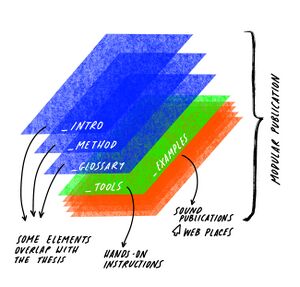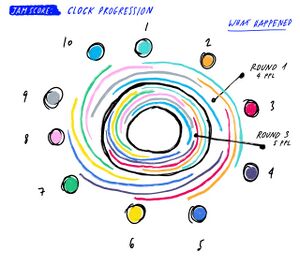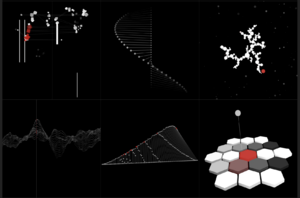Al's XPUB2 proposal draft: Difference between revisions
| Line 84: | Line 84: | ||
==<span style="color: white; font-family: Menlo; text-decoration:none; background-color: #0033ff; padding-top: 0.1vw; padding-bottom: 0.1vw; padding-left: 0.1vw; padding-right: 0.2vw;"> Relation to a larger context </span>== | ==<span style="color: white; font-family: Menlo; text-decoration:none; background-color: #0033ff; padding-top: 0.1vw; padding-bottom: 0.1vw; padding-left: 0.1vw; padding-right: 0.2vw;"> Relation to a larger context </span>== | ||
[position in relation to the other people doing something similar]<br> | |||
[accessibility] <br> | [accessibility] <br> | ||
[collective publishing practices] <br> | [collective publishing practices] <br> | ||
Revision as of 17:32, 17 November 2022
// back to Ål's main page
// back to Graduate Seminar
Questions
_What do you want to make? _How do you plan to make it? _What is your timetable? [stages] [deadlines] _Why do you want to make it? _Who can help you and how? _Relation to previous practice _Relation to a larger context _References/bibliography _Who is the work for (part of why do you want to make it)
What do you want to make?
A handbook presenting a method to produce and publish collective sound-based publications. This hands-on guide will explore an applied method of deep listening sound jams by inviting participants to participate in a collective sound-making and publishing process. By sound jams, I understand any facilitated process of sound-making and publishing that includes more than one person.
The project focuses on bringing deeper attention to sound in the ways we perceive it, and the ways we respond to it. In the project, I will explore various ways to facilitate sound-making and publishing moments on the basis of listening and responding. The method is based on the concept of deep listening, originally developed by musician and educator Pauline Oliveros. In her practice, Oliveros investigated new ways to focus attention on music including her concept of deep listening - “a practice that is intended to heighten and expand consciousness of sound in as many dimensions of awareness and attentional dynamics as humanly possible”.
The sound jams, being various ways of collective sound-making and publishing without the restriction of time, space, instruments or format, will be implemented in collaboration with my classmate Mitsa Chaida. Our researches will meet in the moments of experiments with other participants in order to try out different methods and tools.
Sound is my choice for the core medium of this project because even though we are surrounded by it on a daily basis, it still feels quite inaccessible for many educators, facilitators, artists and artivists. Often associated with music, it often is a reserved territory for people with musical training and sound artists. In reality, it is far more accessible and there are many ways sound-making can be open for participants from any kind of background. Thus, this handbook aims at bringing another medium (or opening more possibilities for exploration of it) to artists, educators, publishers and collectives.
Why do you want to make it?
Facilitation is a substantial element of my artistic practice. Since 2016, I am experimenting with various ways of creating time and space for people to try out new artistic tools, no matter their previous experiences and training. Visual arts and digital communication were mainly the focus of the tools I was researching, but as a mixed-media artist, I am interested in bringing more sound as a format to these laboratories. During the first academic year of my studies at Experimental Publishing, I already noticed my increased interest in using more sound in my artistic practice. Highlights of my research and experiments were the pieces made for Special Issue 18: Radio Implicancies; the care-taking process of facilitating and the editorial work for some weekly releases; as well as participation in improvisational jams with the other XPUB students. I also facilitated my first sound-based artistic residency in September 2022, which allowed me to bring a new medium to my facilitation practice, a medium that worked well in a group of people, and that was a completely new form of expression to many of the participants in the workshop.
This project is also born out of the frustration of feeling oftentimes excluded from jamming sessions because of not being a musician (not having musical training). The element of collective making is also an important entry point for me. I am interested in exploring opportunities for collaborative creative work. I aim at bringing and establishing some principles in my art and facilitation practice: openness, inclusivity, improvisation and collectiveness. I want to create a safe space for experiments, where everyone is welcome, no matter their previous experiences and training.
How do you plan to make it?
[research of methods for collective sound-making] I would like to start with a research of collective-sound making methods that are already published by other artists. Also, I will look for examples and inspirations of sound publications. Which of the sound publications I find interesting are done by a collective, a group of people. What is their process?
[sound jam experiments] Simultaneously, I would like to test experiments of collective sound-making and publishing. Since I already have facilitated a few moments, I would like to reflect on them and create prototypes for publishing them - as a tool, part of the handbook; and as a sound publication, an example.
[instruments] Whatever instruments you give to the participants in jam, shapes the whole experience. Thus, experimenting with giving various types of tools to make sound with, is another layer in the research to be taken into consideration, even though it is not the focus of the project.
[research publishing tools] Researching tools for publishing, in connection with collective publishing practices. What are the ways to share sound-based creations? Which one of them can be or already are collaborative?
[put things together] Describing the tools for collective sound-based publications making - how can we make sounds together; what are the ways to listen better, to respond with sound, to publish our sound works, to do it collectively?
What is your timetable?
_1 // december-january // research of existing methods for collective sound-making & publishing
_2 // december-january // drafting, shaping, testing tools for collective sound-making and publishing
_3 // january-march // facilitating and documenting sound jams & creating prototyping publication modules out of them
_4 // march-april // revision, reflection, revisiting instructions, feedback
_5 // april //prototyping the publication (with printable and digital elements)
_6 // may-june // making the publication
_7 // june-july // presenting the publication (grad show)
Who can help you and how?
For facilitating the sound jams, I will need the help of my friend and colleague Mitsa. Together, we already have been part of several workshops and sessions of sound-making exploration. We see our sound jams as a space for trying out our tools and reflecting on the way they are perceived by the participants. They are a way to do experiments and get immediate feedback about our facilitation tools, or the instruments we are testing.
For having participants in the jams and giving feedback, I would need the help of our XPUB2 group - to join our jam sessions. For the more open jams, would need to help in organising the event and getting materials (instruments, snacks, drinks). I plan to organise jams with PZI Archipelago in school, can contact Research station, too. For more public jams, will check with contacts outside school, such as Tisa (WORM, Re#sister), Manetta and Cristina (Varia), Leslie (for contact with local spaces) etc.
For finding space for the sound jams, I will need help to find locations and venues. Thus, I would need the help of our local connections in Rotterdam. Made a list with ideas here.
For prototyping and creating the publication, I will need help with laying it out, printing and assembling the way I imagine (because I have no prior experience in creating such a publication). I believe my friends and colleagues Jian and Gersande can help me with it.
For material base, I will need some instruments for sound-making, recorders, speakers. XPUB tutors can help with some equipment, for more - can make calls and ask local contacts, too. WDKA rental has some limited equipment, should explore also other options. Have to check what budgets do we have for making our master projects.
Relation to previous practice
[facilitation] Since 2016, I am part of Nomadways collective - an association based in France that designs and implements artistic experimental workshops for artists, activists, and educators - artivists. As a project designer and facilitator, I have experimented with various mediums that we often mix with topic. In our traditionally 2-week workshops, we create space for people to try out new tools and look for ways to implement them in their practice. Adding a whole new library of tools to my facilitation practice is a quite relevant endevour, but sharing it freely with the public is exactly what I am interested in terms of expanding and developing my work.
[sound-based experiments] My complicated relation to music and sound started in my early years of childhood when I was attracted to music but discouraged by my parents to pursue any musical training (they were calling me and my sisters “musical invalids”). Thus, I became a listener. Listening to music and responding to it in my own ways, became part of my daily life. Later, I triend various activities as a user of music: I danced and choreographed; I curated music and performed as a DJ. But my desire to create was never fulfilled. Last September, I co-facilitated a 2-week music and sound residency in Burlats, France. It was a challenge for me to be a trainer in an Erasmus+ training course and feeling as an imposter because of the lack of my training in music. However, it turned out to be liberating.
[xpub year 1] Highlight of my last year was Special Issue 18: Radio Implicancies. As a care-taker, I loved pre-editing, hosting and facilitating a weekly release. As a contributor - to reflect on a read or research with sound. I enjoyed mixing, editing, publishing, but also making and experimenting with sound. I participated in several jamming sessions and felt included. I would like to create such spaces in the future and make that part of my artistic practice.
[visual translation & illustration] are my talents and skills that are always present in my work. They are part of my research, planning but also designing and illustrating the final publication.
Relation to a larger context
[position in relation to the other people doing something similar]
[accessibility]
[collective publishing practices]
[mixed media toolset]
[sound in artistic research]
References/bibliography
WIP - what informs the research
reads
Oliveros, P., 2005. Deep Listening. New York. Deep Listening Publications. [annotated pad]
adrienne maree brown, 2019. Pleasure Activism. The Politics of Feeling Good. Chico, Edinburgh. AK Press. [annotated pad]
Evens, A., 2005. Sound Ideas: Music, Machines & Experience. U of Minnesota Press [annotated pad]
Kreidler, J. 2013. loadbang. Programming Electronic Music in Pure Data. 2nd edition. Hofheim: Wolke Verlag.
Weiss, A., 2001. Experimental Sound & Radio. The MIT Press.
Groot, M. 2019. The Amateur's Armour. [online] Available at: <https://underbelly.nu/wp-content/uploads/2015/04/The-Amateurs-Armour.pdf> [Accessed 11 October 2022].
sound publications
Brown, A. R., 2022. Beneath Maiwar.[online] Available at: <https://www.explodingart.com/arb/2022/06/28/beneath-maiwar/> [Accessed 30 September 2022]. [annotated pad]
Nagy, A., 2018. Hackpact / Sonification Studies. [online] Available at: <https://stc.github.io/HackPact/> [Accessed 30 September 2022]. [annotated pad]
Who is the work for?
_educators: people who are facilitating various educational activities and are looking for ways to bring more mixed media in their activities;
_artists: who are looking for new techniques for their practice and ways to experiment, boost their creative process; to find more ways to reflect over topics and contents;
Research places
wiki
▶ Al Nik's Hackpact
▶ Sound jams research
wip
▶ the first draft pad [created during the Graduate Seminar on 29-09-2022]
▶ jams ideas
▶ references - collective pad with Mitsa
▶ tagging and mapping research elements
▶ wikimedia setup - creating a space for collaborative work; for documentation and presentation of the sound-based publications from the research // work in progress
research pads
▶ glossary
▶ audiozines
▶ pure data
▶ live coding



